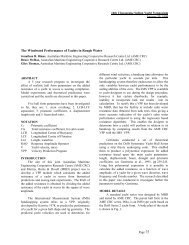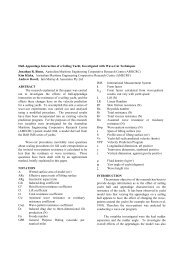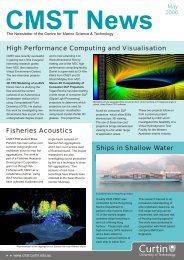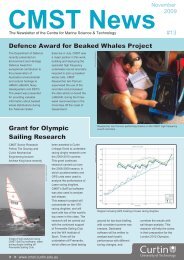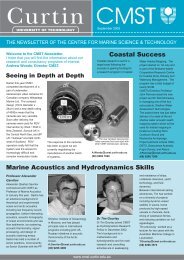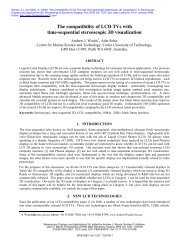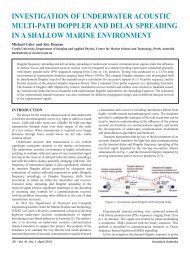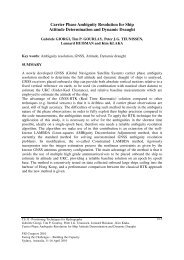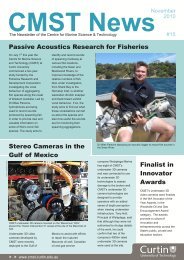Blue whale calling in the Rottnest trench-2000, Western ... - ANP
Blue whale calling in the Rottnest trench-2000, Western ... - ANP
Blue whale calling in the Rottnest trench-2000, Western ... - ANP
You also want an ePaper? Increase the reach of your titles
YUMPU automatically turns print PDFs into web optimized ePapers that Google loves.
The strong refraction bought about by <strong>the</strong> change <strong>in</strong> sound speed structure with depth needed to<br />
be dealt with <strong>in</strong> estimat<strong>in</strong>g <strong>the</strong> multipath arrivals at any specified orientation of source and<br />
receiver. Thus a sound propagation model which predicted ray paths from a source was used.<br />
The Bellhop model (Porter, 1994) was run with a 75 and 200 m depth Leeuw<strong>in</strong> current (as per<br />
Figure 4 top and bottom extrapolated to depth as per Figure 5), source depths of 20 and 40 m and<br />
constant water depth of 450 m (ie. <strong>the</strong> bluey logger depth). The model output depth and range<br />
vectors for rays result<strong>in</strong>g from each launch angle selected. For each model run, 600 rays between<br />
launch angles of -50 o (look<strong>in</strong>g up) and 50 o (look<strong>in</strong>g down) were used. A simplified output of this<br />
model run, with <strong>the</strong> bottom bounces not shown, was presented <strong>in</strong> Figure 15 (section 3.2). S<strong>in</strong>ce<br />
<strong>the</strong> receiver was bottomed <strong>the</strong> Bellhop output was <strong>the</strong>n used to f<strong>in</strong>d <strong>the</strong> various arrivals for<br />
specified locations along <strong>the</strong> seafloor. The travel path along each ray (or multipath signal) to <strong>the</strong><br />
specified bottom location was calculated, as was <strong>the</strong> travel time along <strong>the</strong> ray, which was found<br />
by us<strong>in</strong>g <strong>the</strong> water column sound speed structure and <strong>the</strong> ray path vectors. Thus an output<br />
consist<strong>in</strong>g of <strong>the</strong> horizontal range to a source at 20 or 40 m depth, and <strong>the</strong> associated travel time<br />
and travel path range, for <strong>the</strong> first eight arrivals was obta<strong>in</strong>ed over horizontal ranges from 400 m<br />
(direct arrival only) to 5 km. Only shallow sources were used <strong>in</strong> <strong>the</strong> Bellhop ray path modell<strong>in</strong>g<br />
as all previous workers whom have calculated <strong>the</strong> <strong>call<strong>in</strong>g</strong> depth of blue <strong>whale</strong>s have reported<br />
<strong>call<strong>in</strong>g</strong> depths of less than 40 m (eg. D'Spa<strong>in</strong> et al 1995; Thode et al <strong>2000</strong>).<br />
For sources near <strong>the</strong> surface (compared to <strong>the</strong> water depth), such as <strong>the</strong> blue <strong>whale</strong>, <strong>the</strong> multiple<br />
bounce paths arrive at <strong>the</strong> receiver <strong>in</strong> groups of two closely spaced paths. This can be seen on<br />
Figure 21 where <strong>the</strong> different arrival times relative to <strong>the</strong> direct arrival for a 65 Hz signal are<br />
presented with range, and each group arrives as a 'set'.<br />
Figure 21: Arrival times of multipath signals relative to <strong>the</strong> direct arrival, for <strong>the</strong> bluey logger site, a 20 m source,<br />
200 m deep Leeuw<strong>in</strong> current, at 65 Hz. The arrivals come <strong>in</strong> closely spaced pairs with <strong>the</strong> lowest arrival pair <strong>the</strong><br />
direct (zeroed) and surface arrivals, <strong>the</strong> next group <strong>the</strong> bottom-surface and surface-bottom-surface (dotted l<strong>in</strong>e)<br />
arrivals, and <strong>the</strong> top group, <strong>the</strong> bottom-surface-bottom-surface and surface-bottom-surface-bottom-surface (dotted<br />
l<strong>in</strong>e) arrivals.<br />
If <strong>the</strong> outgo<strong>in</strong>g signal pulse is sufficiently short, or generally less than 10 ms long, <strong>the</strong> different<br />
arrivals <strong>in</strong> each path set may be resolved, but if <strong>the</strong>y are not <strong>the</strong>n each set of two arrivals will<br />
comb<strong>in</strong>e to form a received bounce path. The latter is <strong>the</strong> case with <strong>the</strong> blue <strong>whale</strong> 65-66 Hz<br />
pulses recorded, <strong>the</strong>y were generally of <strong>the</strong> order of 100-200 ms long, which meant <strong>the</strong> two<br />
arrivals comb<strong>in</strong>ed. S<strong>in</strong>ce <strong>the</strong> two arrivals for each path set (termed a path from here on) will be<br />
24



